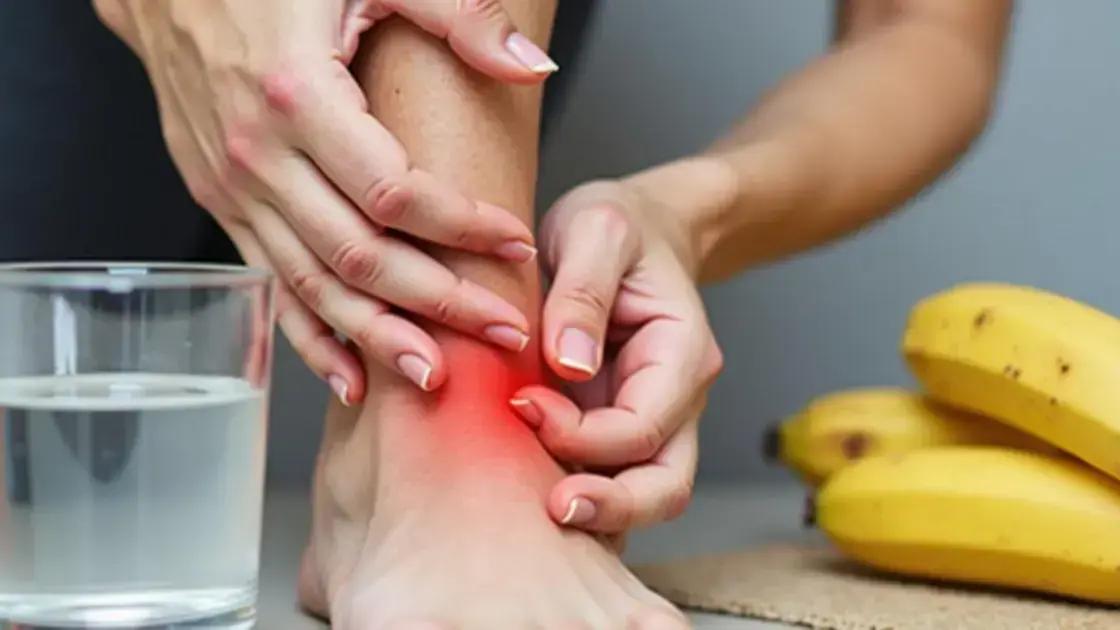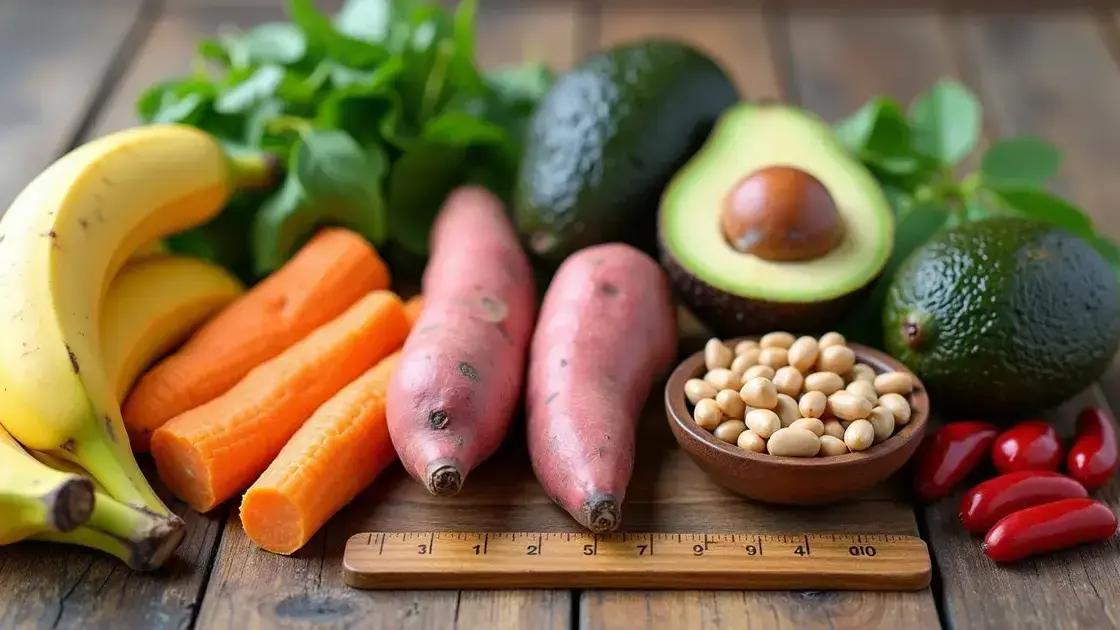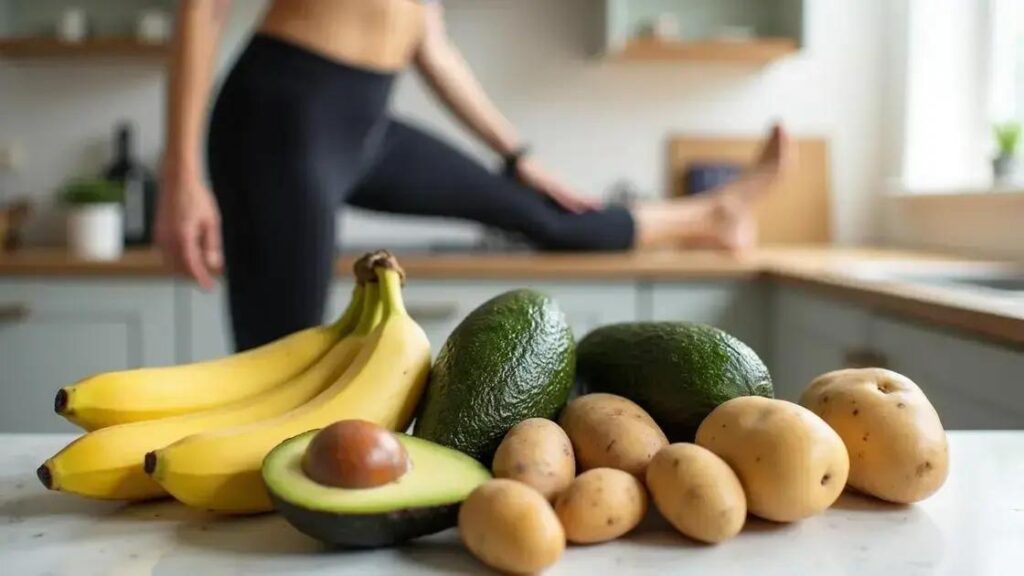To address leg cramps naturally, incorporate potassium-rich foods like bananas, sweet potatoes, and spinach into your diet. Stay hydrated, practice stretching, and use natural remedies such as warm compresses and massage for relief.
Are you tired of waking up in the middle of the night with painful leg cramps? How to address leg cramps with potassium-rich foods might be the solution you’ve been looking for! These cramps can interrupt your sleep and daily activities, but understanding their causes and how potassium plays a vital role in muscle function can help. In this guide, we’ll delve into effective dietary changes and natural remedies. Get ready to discover how some simple adjustments can lead to significant relief!
Understanding Leg Cramps: Causes and Symptoms

Leg cramps are sudden and involuntary muscle contractions, often occurring in the legs. Understanding leg cramps: causes and symptoms is crucial for finding effective relief. These cramps can be quite painful and usually last from a few seconds to several minutes. They can happen during physical activity, at rest, or even during sleep.
Causes of Leg Cramps
Several factors can lead to leg cramps. One common cause is dehydration, which reduces blood volume and can lead to cramping. Muscle fatigue from overexertion or prolonged sitting can also trigger cramps. In some cases, poor circulation or an imbalance of minerals in your body, particularly potassium, calcium, and magnesium, may contribute to these painful spasms.
Symptoms of Leg Cramps
The primary symptom is a sudden, sharp pain in the affected muscle, often followed by soreness in the area after the cramp subsides. You might also notice a firm or hard muscle during a cramp, which is a direct indication of muscle contraction. Sometimes, cramps can be frequent, especially at night, which is known as Nocturnal Leg Cramps.
When to Seek Medical Help
While leg cramps are usually harmless, they can sometimes indicate underlying health issues. If you experience frequent or severe cramps, especially if they are accompanied by swelling, redness, or other unusual symptoms, it’s essential to consult a healthcare professional. They can help identify if there is an underlying condition needing treatment.
Top Potassium-Rich Foods for Prevention

Including potassium-rich foods in your diet is a great way to help prevent leg cramps. These foods enhance muscle function and can balance electrolytes in your body. Here are some of the top potassium-rich options you should consider:
1. Bananas
Bananas are famous for being a potassium powerhouse. Each banana contains about 422 mg of potassium. They are not only delicious but also easy to add to smoothies, cereals, or enjoy as a quick snack.
2. Sweet Potatoes
Sweet potatoes are nutritious and sweet. A medium sweet potato has approximately sweetpotato sweetpotato sweetpotato sweetpotato sweetpotato sweetpotato sweetpotato mg of potassium, making them an excellent choice for maintaining healthy muscle function. They can be baked, mashed, or added to soups and stews.
3. Spinach
Spinach is a leafy green that is not only rich in potassium but also offers various vitamins and minerals. One cup of cooked spinach has around 839 mg of potassium. Add it to salads, smoothies, or sauté it as a side dish to boost your potassium intake.
4. Avocados
Avocados are creamy and nutrient-rich. One avocado provides about 975 mg of potassium. They can be spread on toast, mixed in salads, or used in smoothies, making them a versatile addition to your meals.
5. Beans
Beans, including black beans and kidney beans, are excellent sources of potassium. One cup of cooked beans can contain up to 600 mg of potassium. They can be added to salads, soups, or used as a meat substitute in various dishes.
Incorporating these potassium-rich foods into your daily diet can help you significantly reduce the chances of experiencing leg cramps. Try to aim for a balanced diet that includes these items regularly for the best results.
How to Incorporate These Foods into Your Diet

Incorporating potassium-rich foods into your diet is easy and can be very tasty! Here are some simple ways to make these foods a regular part of your meals:
1. Start Your Day Right
Begin your day with a breakfast smoothie that includes a banana and spinach. Just blend together some milk or yogurt, a banana, a handful of spinach, and your favorite fruits for a delicious and nutritious start!
2. Snack Smart
Choose healthy snacks like avocado toast. Simply mash up some avocado on whole-grain bread, sprinkle with salt and pepper, and enjoy. This delicious snack keeps you full and gives you a potassium boost.
3. Add to Salads
Include potassium-rich foods in your salads. Add sliced sweet potatoes, black beans, or kidney beans for added flavor and nutrients. These ingredients not only enhance the taste but also help keep cramps at bay.
4. Try New Recipes
Experiment with recipes that feature potassium-rich ingredients. For example, try roasted sweet potatoes and black beans with cilantro for a tasty side dish or main course. These flavors work well together and are packed with nutrition.
5. Plan Your Meals
When planning your meals, make sure to include different potassium-rich foods throughout the week. On Monday, have a bean soup, and on Tuesday, enjoy a spinach and banana smoothie. This way, you can keep your meals interesting while boosting your potassium intake.
By making these small changes, you can easily incorporate potassium-rich foods into your regular diet and help prevent leg cramps.
Natural Remedies and Tips for Relief

When dealing with leg cramps, there are various natural remedies and tips for relief that can help soothe discomfort effectively. Here are some useful methods:
1. Stretching
If you experience a leg cramp, gently stretching the affected muscle can provide quick relief. For calf cramps, try standing up and placing your weight on the cramping leg while keeping your knee straight.
2. Hydration
Staying well-hydrated is essential. Drink plenty of water throughout the day to keep muscles functioning properly. Drinking electrolyte-rich beverages can also be beneficial.
3. Warm Compress
Applying a warm compress or heating pad to the cramped muscle may help relax it. If a heating pad is not available, taking a warm bath can have similar soothing effects.
4. Massage
Gently massaging the cramped muscle can improve blood circulation and relieve tension. Use your fingers to apply pressure and knead the area until the cramp subsides.
5. Essential Oils
Using essential oils like lavender or peppermint mixed with a carrier oil can provide relief. Rub the mixture onto the affected muscle for a calming effect.
6. Proper Posture
Maintaining proper posture while sitting or standing can help prevent leg cramps. Make sure your feet are flat on the floor and avoid crossing your legs for long periods.
7. Diet Considerations
Spicing up your diet with potassium-rich foods can prevent future cramps. Consider adding bananas, sweet potatoes, and leafy greens regularly to your eating plan.
By trying these natural remedies, you can find ways to alleviate leg cramps and help keep them from returning in the future.
In Summary: Your Path to Relief from Leg Cramps
Addressing leg cramps doesn’t have to be a daily struggle. By understanding the causes and symptoms, you can make informed choices about prevention and treatment.
Incorporating potassium-rich foods into your diet can significantly reduce the frequency and intensity of cramps. Making simple changes to your meals, combined with natural remedies and proactive tips, will help you alleviate discomfort and promote muscle health.
Remember to stay hydrated, stretch regularly, and pay attention to your body’s signals. With these strategies, you can enjoy a more comfortable and active lifestyle.
FAQ – Frequently Asked Questions about Leg Cramps and Potassium-Rich Foods
What are leg cramps and what causes them?
Leg cramps are sudden and involuntary muscle contractions that can cause severe pain. They can be caused by dehydration, muscle fatigue, or an imbalance of minerals like potassium.
How can potassium-rich foods help prevent leg cramps?
Potassium-rich foods support muscle function and help maintain fluid balance in the body, which can help reduce the occurrence of leg cramps.
What are some potassium-rich foods I should include in my diet?
Some excellent potassium-rich foods include bananas, sweet potatoes, spinach, avocados, and beans.
What natural remedies can I try for relief from leg cramps?
Natural remedies include stretching, staying hydrated, using warm compresses, and massaging the affected area. Essential oils may also provide relief.
How can I incorporate more potassium into my meals?
You can start your day with a banana smoothie, add sweet potatoes to your salads, or enjoy avocado toast as a snack to increase your potassium intake.
When should I see a doctor about my leg cramps?
If you experience frequent or severe leg cramps, especially with swelling or other unusual symptoms, consult a healthcare professional to rule out underlying issues.













